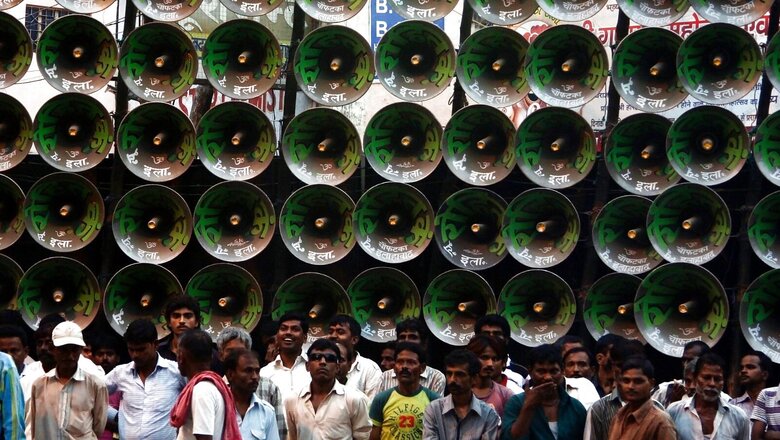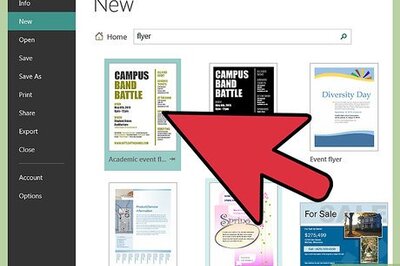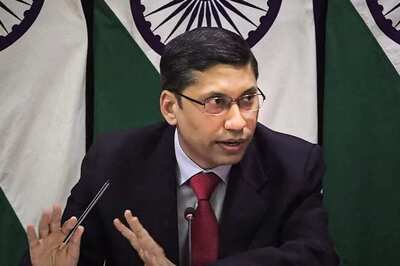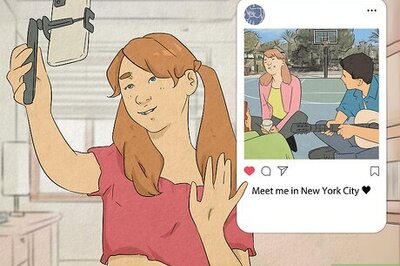
views
The loudspeaker row is heating up in India. After MNS chief Raj Thackeray’s call to ban the use of the equipment by mosques, the Maharashtra government is set to meet today to issue directions on the use of speakers in the state.
The controversy comes on the heels of communal violence witnessed in various states around Hanuman Jayanti festivities — in Delhi, Andhra Pradesh, Karnataka, and Uttarakhand. Other communal-related clashes were also seen in Gujarat and Karnataka.
As debate around the issue unfolds, what are the rules related to the use of loudspeakers in India? We take a look:
Noise and What Pollutant Laws Say
The use of a loudspeaker produces noise. Noise has been defined as “unwanted sound, a potential health and communication hazard dumped into the environment with regard to the adverse effect it may have on unwilling ears.”
Music is sound that pleases the listeners, while noise is sound that causes pain and annoyance. What is music to one person may be noise to another. Noise is defined as a ‘air pollutant’ in Section 2(a) of the Air (Prevention and Control of Pollution) Act of 1981.
According to Section 2(a), a “air pollutant” is any solid, liquid, or gaseous substance, including noise, present in the atmosphere in such concentrations as to be or tend to be harmful to humans, other living creatures, plants, property, or the environment, reports said.
Noise pollution has been designated as a distinct phrase from noise. Noise is defined as “a sound; a harsh disagreeable sound, or such sound; a pollution, an excessive or annoying degree of noise in a particular area, e.g. from traffic or aeroplane engines.”
CPCB and Permissible Noise Levels
The CPCB has established the permissible noise levels in India for various areas. The acceptable level of noise in different zones for both day and night has been defined by noise pollution rules. The permissible limit in industrial areas is 75 dB during the day and 70 dB at night. During the day and night, it is 65 dB and 55 dB in commercial areas, and 55 dB and 45 dB in residential areas, according to reports.
Previously, the Air (Prevention and Control of Pollution) Act of 1981 addressed noise pollution and its sources. However, they are now governed separately by the Noise Pollution (Regulation and Control) Rules, 2000. The Environment (Protection) Rules, 1986 also include noise standards for motor vehicles, air conditioners, refrigerators, diesel generators, and certain types of construction equipment. Similarly, violating noise pollution norms while using diesel generator sets can result in the sets being sealed and a fine ranging from Rs 10,000 to Rs 100,000, depending on the size of the set.
Violations involving sound-emitting construction equipment can result in a Rs 50,000 fine as well as the seizure or sealing of the equipment.
Court Orders On Loudspeakers:
SC’s June 2005 Order
The Supreme Court had banned the use of loudspeakers and music systems in public places between 10 p.m. and 6 a.m. (except in cases of public emergencies) in July 2005, citing the serious effects of noise pollution on the health of those who live in such areas.
SC’s Order on Festivities
The Supreme Court ruled on October 28, 2005, that loudspeakers could be used until midnight on festive occasions for 15 days a year. A bench comprised of then-Chairman of the Supreme Court RC Lahoti and Justice Ashok Bhan upheld the constitutionality of a statutory rule allowing states to relax sound pollution norms, including the use of loudspeakers until midnight on festive and religious occasions, according to a report by India Today.
The order was issued in response to an appeal filed by some state governments, who claimed that the Supreme Court’s July 18 order, which imposed a blanket ban on the use of loudspeakers between 10 p.m. and 6 a.m., had taken away the right granted to them under the Noise Pollution (Control and Regulation) Rules 2000.
However, the Supreme Court ruled that state governments could not delegate the authority to lift the ban to other authorities.
What the Bombay HC Has Said
The Bombay High Court ruled in August 2016 that the use of loudspeakers was not a fundamental right. The Bombay High Court ruled that no religion or sect could claim that the right to use a loudspeaker or public address system was a fundamental right guaranteed by Article 25 of the Indian Constitution.
It was also ordered that if a religious establishment was located in a Silence Zone, the rules prohibiting the use of loudspeakers and other forms of sound producing systems in such zones be followed by such religious establishments.
Uttarakhand HC’s 5 Decibel Limit & Takeback
The Uttarakhand High Court established a five-decibel limit for loudspeakers on June 26, 2018. The Uttarakhand High Court directed the state government that the use of loudspeakers, even during the day, be conditional on the user agreeing that the noise level would not exceed five decibels. A pin falling to the ground makes 10 decibels of noise, as does a person breathing.
The court ordered the state government to ensure that no person or organisation, including religious bodies, uses a loudspeaker or public address system without the written permission of the appropriate authorities.
“The loudspeakers continue to blare even after 12 a.m. The court stated that “the loudspeaker cannot be used without written permission from the authority, even by temples, mosques, and gurdwaras.”
Then, in July 2020, the Uttarakhand High Court modified its earlier order issued in June 2018 limiting the noise level to five decibels, calling it a “accidental error”. Thus, the HC effectively paved the way for the lifting of the state’s ban on the use of loudspeakers in religious institutions.
The court order was modified in response to an application filed by the Jama Masjid of Bazpur area in Udham Singh Nagar district seeking permission to use loudspeakers.
How the Issue Has Unfolded in Karnataka
The Karnataka High Court banned the use of loudspeakers after 10 p.m. in September 2018. When authorities ban loudspeakers, the high court directed that the Supreme Court’s guidelines specifying permissible sound levels be followed.
The order was issued after a resident of Koppal challenged the deputy commissioner’s (DC) order prohibiting the use of loudspeakers in the district until December 31, 2018. Gavisiddappa, secretary of Hindu Mahamandali, filed an appeal with the High Court against the Koppal district administration, which issued an order on September 4, 2018 under the Noise Pollution (Regulation and Control) Rules and the Environment (Protection) Act.
This order prohibited the use of audio equipment that exceeded the prescribed limit between September 4 and December 31, 2018.
Then, in January, 2021, the Karnataka High Court directed the state government to take action against illegal loudspeakers at religious sites in the state. It ordered the state government to immediately issue orders to the police and the Karnataka State Pollution Control Board (KSPCB) to take action against the use of amplifiers and loudspeakers in religious places in violation of noise pollution laws and Supreme Court orders.
A division bench comprised of Chief Justice Abhay Shreeniwas Oka and Justice Sachin Shankar Magadum was hearing a PIL petition filed by Girish Bharadwaj of Bengaluru.
According to Article 21 of the Constitution, the state government is required to protect citizens’ rights. It was noted that the court had received several PIL petitions concerning the illegal use of loudspeakers in religious places in violation of the Noise Pollution (Regulation and Control) Rules, 2000, issued under the Environment Protection Act, 1986.
In November 2021, the Karnataka High Court asked the state government to explain the legal provisions that allowed loudspeakers and public address systems in mosques, as well as what steps are being taken to limit their use.
The division bench, presided over by Chief Justice Ritu Raj Awasthi, was hearing a petition filed by Girish Bharadwaj regarding noise pollution caused by mosques in Bengaluru’s Thanisandra district. He asked the court for guidance on how to effectively implement the law governing sound pollution control.
Punjab and Haryana HC
The Punjab and Haryana High Court banned the use of loudspeakers in public places, including religious institutions, in July 2019. According to the court, public address systems should only be used with prior permission, and the noise level should never exceed the allowable limit.
“The States of Punjab, Haryana, and the Union Territory of Chandigarh are directed to ensure that no loudspeaker or public address system shall be used by any person, including religious bodies, in temples, mosques, and gurdwaras without written permission of the authority, even during daytime, and that too, by obtaining an undertaking that the noise level shall not exceed more than 10dB(A) peripheral noise level,” the order stated.
What Allahabad HC Said About Loudspeaker Use by Mosques
The Allahabad High Court ruled on May 15, 2020, that azaan could only be recited by a muezzin (an Islamic priest) from the minarets of mosques by human voice, without the use of any amplifying device or loudspeakers.
“We are of the opinion that azaan may be an essential and integral part of Islam, but its recitation through loudspeakers or other sound amplifying devices cannot be said to be an integral part of the religion warranting protection of the fundamental right enshrined in Article 25, which is even otherwise subject to public order, morality, or health, as well as other provisions in Part III of the Constitution,” the bench ruled, according to the report.
Read all the Latest News India and Breaking News here




















Comments
0 comment